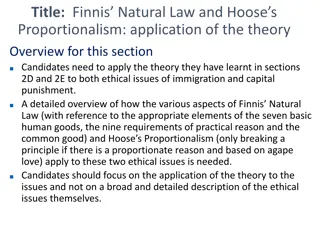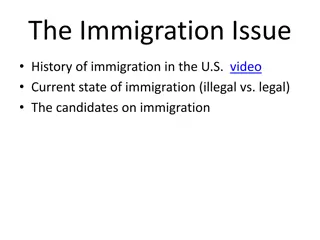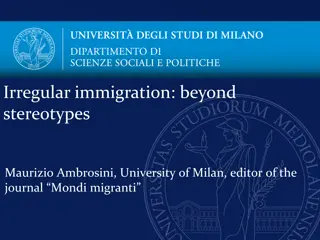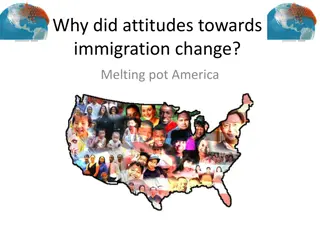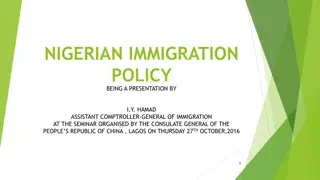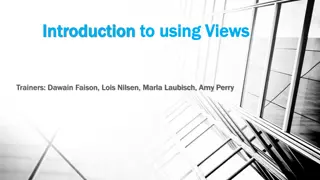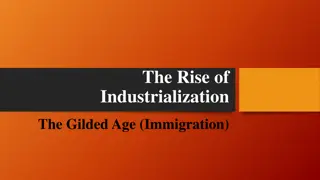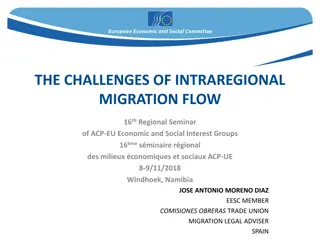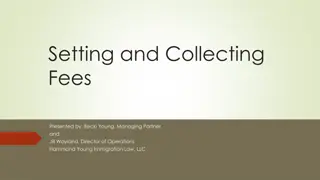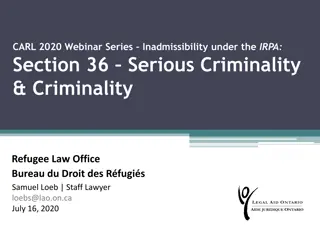Exploring Views on Immigration in Europe through Interactive Lessons
Dive into a thought-provoking lesson plan that encourages students to discuss migration, ambitions, and perceptions of immigrants in Europe. The activities prompt critical thinking about potential challenges and expectations when relocating to a new country. Students analyze varying attitudes towards immigrants in different European countries based on factors like education, income, gender, residence, and age. The lesson also touches on how social scientists use data to measure societal dimensions and encourages reflection on personal views regarding immigrants and national priorities. Engage in discussions, games, and hypothetical scenarios to gain insights into the complex issues surrounding immigration.
Download Presentation

Please find below an Image/Link to download the presentation.
The content on the website is provided AS IS for your information and personal use only. It may not be sold, licensed, or shared on other websites without obtaining consent from the author. Download presentation by click this link. If you encounter any issues during the download, it is possible that the publisher has removed the file from their server.
E N D
Presentation Transcript
Homework Starting activities: Happy family (getting to know each other asking about own migration history and ambitions) Memory (?) Card Game (?)
Lessons about Views on Immigrants in Europe Lesson developed for Name of the Schools
IMAGINE (ONE OF) YOUR PARENTS GET(S) A VERY GOOD JOB IN LATVIA, GREECE, TURKEY OR SERBIA. YOUR FAMILY DECIDES TO MIGRATE TO THAT COUNTRY, YOU CANNOT STAY IN THE NETHERLANDS ANYMORE. 1. WHAT WOULD CHANGE FOR YOU? WHAT EFFORTS WOULD YOU HAVE TO MAKE? 2. WHAT WOULD YOU PERSONALLY EXPECT/APPRECIATE TO MAKE YOUR START IN THE COUNTRY EASIER? LATVIA SERBIA GREECE TURKEY Source: https://mapswire.com/europe/political-maps/
IN WHICH COUNTRIES DO YOU THINK PEOPLE HAVE MORE POSITIVE FEELINGS AND IN WHICH COUNTRIES MORE NEGATIVE FEELINGS TOWARDS IMMIGRANTS? NETHERLANDS - ITALY - SPAIN - FINLAND - GERMANY - HUNGARY - SWEDEN I THINK IN . PEOPLE WILL HAVE MORE/LESS POSITIVE/NEGATIVE FEELINGS TOWARDS IMMIGRANTS, BECAUSE Source: https://mapswire.com/europe/political-maps/
GENERALLY WHICH PEOPLE DO YOU THINK HAVE MORE POSITIVE/ MORE NEGATIVE FEELINGS TOWARDS IMMIGRANTS? THINK ABOUT: EDUCATION (low/high) INCOME (low/high) GENDER (men/women) RESIDENCE (small towns/big cities) AGE (young/old) I THINK THAT .PEOPLE .. WILL HAVE MORE/LESS POSITIVE/NEGATIVE FEELINGS TOWARDS IMMIGRANTS, BECAUSE
HOW DO WE KNOW? - As you do did in the previous activity, social scientists construct hypothesis, which have to be underpinned by arguments. If possible then social scientists try to collect data to prove their ideas with their findings. - - You will now answer questions social scientists use to measure dimensions. A dimension can be imagined as a line with at the two ends two opposed points of view. dimension ++ - - Only coffee Only tea Mostly coffee Mostly tea Coffee and tea - One of these dimensions is about immigrants, the other dimension is about priorities for your country at the moment. Sources: https://commons.wikimedia.org/wiki/File:A_small_cup_of_coffee.JPG https://tr.m.wikipedia.org/wiki/Dosya:Lipton-mug-tea.jpg
DO YOU UNDERSTAND THE QUESTIONS AND WHAT YOU HAVE TO DO? You will have to answer the follwing questions about immigrants on a scale of 0-10 Immigrants take jobs away from Dutch people (0= I don t agree at all 10= I agree totally) Immigrants make crime problems worse (0= I don t agree at all 10= I agree totally) Immigrants are a strain on a country s welfare system (0= I don t agree at all 10= I agree totally) You will have to give the first and second priority for The Netherlands for the next 10 years A Maintaining order in the nation B Giving people more say in important government decisions C Fighting rising prices D Protecting freedom of speech
WHATS YOUR OPINION? GO TO www.atlasofeuropeanvalues.eu ENTER Classroom DUTCH STUDENTS: JOIN Classroom USE CODE .. FINNISH STUDENTS: JOIN Classroom USE CODE .. ANSWER THE QUESTIONS CAREFULLY. READY? ANSWERS & READ THE TEXT EXIT CLASSROOM & WRITE DOWN REASONS FOR YOUR
READ THE TEXT CAREFULLY. - Do you have any questions? Source: https://pixabay.com/illustrations/question-mark-note-duplicate-2405202/
NOW THE CLASSROOM RESULTS SHOULD BE DISCUSSED - - The results of the classes will first only be shown for the whole class. First the results for the classes will be compared with the average NL-FL results: How could we explain similarities/differences? Then the results of the individual students will be displayed? Do we see big differences? Why (not)? How could it be in NL/FL as a country, other countries? Then all results for Europe are dipalyed: do we see a correlation for materialism/ethnic threat Then also the average results for Germany, Sweden, Spain, Hungary and Italy will be displayed. What differences can be observed? How can these differences be explained? Then according to the students answers certain groups in the five countries will be displayed: education, income, residence, gender, .. Do we see the theories being confimed or not? - - - - - On the following slide you see the results for all countries (you will display it by the website). Furthermore there are some slides to show (not-)existing other correlations (these slides are optional) -
Results of all countries - Do we see a correlation between (post-) materialism and perceived ethnic threat?
SUMMARIZING THE RESULTS We see that both/only competition theory and contact theory can explain views on immigrants: People with low/high education, low/high income, living in small/big cities, young/old people, men/women have more positive/negative views on immigrants. This can be explained because people with low/high education .. people with low/high income . , people living in small/big cities .., young/old people ., men/women . The following aspects seem to have the most explanatory power: ..
Once immigrants have arrived, what should they do? It is better if immigrants adopt the customs of the country. Immigrants can stick to their own customs. Opinion Line
PROPOSAL Work in mixed groups of 4 - 6 students: Try to develop two concrete actions the we should take now in respect of immigration. They must be SMART: Specific, Measurable, Achievable, Realistic, and Timely. Present your proposals in 2 minutes: what why possible effects?
PROPOSAL Two concrete actions the we should take now in respect of immigration Present your proposals in 2 minutes: what why possible effects?
PROPOSAL Two concrete actions the we should take now in respect of immigration Present your proposals in 2 minutes: what why possible effects? DEBRIEFING
BAGGAGE CHECK Source: https://publicdomainvectors.org/en/free-clipart/Airport-check-in/85125.html How would these people react on your proposals?
BAGGAGE CHECK Source: https://publicdomainvectors.org/en/free-clipart/Airport-check-in/85125.html How would these people react on your proposals? DEBRIEFING


